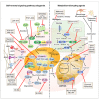Targeting Cancer Stem Cells in Triple-Negative Breast Cancer
- PMID: 31324052
- PMCID: PMC6678244
- DOI: 10.3390/cancers11070965
Targeting Cancer Stem Cells in Triple-Negative Breast Cancer
Abstract
Triple-negative breast cancer (TNBC) is a highly aggressive form of breast cancer that lacks targeted therapy options, and patients diagnosed with TNBC have poorer outcomes than patients with other breast cancer subtypes. Emerging evidence suggests that breast cancer stem cells (BCSCs), which have tumor-initiating potential and possess self-renewal capacity, may be responsible for this poor outcome by promoting therapy resistance, metastasis, and recurrence. TNBC cells have been consistently reported to display cancer stem cell (CSC) signatures at functional, molecular, and transcriptional levels. In recent decades, CSC-targeting strategies have shown therapeutic effects on TNBC in multiple preclinical studies, and some of these strategies are currently being evaluated in clinical trials. Therefore, understanding CSC biology in TNBC has the potential to guide the discovery of novel therapeutic agents in the future. In this review, we focus on the self-renewal signaling pathways (SRSPs) that are aberrantly activated in TNBC cells and discuss the specific signaling components that are involved in the tumor-initiating potential of TNBC cells. Additionally, we describe the molecular mechanisms shared by both TNBC cells and CSCs, including metabolic plasticity, which enables TNBC cells to switch between metabolic pathways according to substrate availability to meet the energetic and biosynthetic demands for rapid growth and survival under harsh conditions. We highlight CSCs as potential key regulators driving the aggressiveness of TNBC. Thus, the manipulation of CSCs in TNBC can be a targeted therapeutic strategy for TNBC in the future.
Keywords: breast cancer stem cell (BCSC); metabolic plasticity; self-renewal signaling pathways; triple-negative breast cancer (TNBC).
Conflict of interest statement
The authors declare that they have no conflict of interest to disclose.
Figures


References
-
- Liedtke C., Mazouni C., Hess K.R., André F., Tordai A., Mejia J.A., Symmans W.F., Gonzalez-Angulo A.M., Hennessy B., Green M. Response to neoadjuvant therapy and long-term survival in patients with triple-negative breast cancer. J. Clin. Oncol. 2008;26:1275–1281. doi: 10.1200/JCO.2007.14.4147. - DOI - PubMed
-
- Ginestier C., Hur M.H., Charafe-Jauffret E., Monville F., Dutcher J., Brown M., Jacquemier J., Viens P., Kleer C.G., Liu S. ALDH1 is a marker of normal and malignant human mammary stem cells and a predictor of poor clinical outcome. Cell Stem Cell. 2007;1:555–567. doi: 10.1016/j.stem.2007.08.014. - DOI - PMC - PubMed
Publication types
Grants and funding
LinkOut - more resources
Full Text Sources

